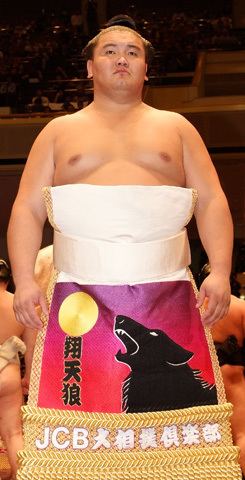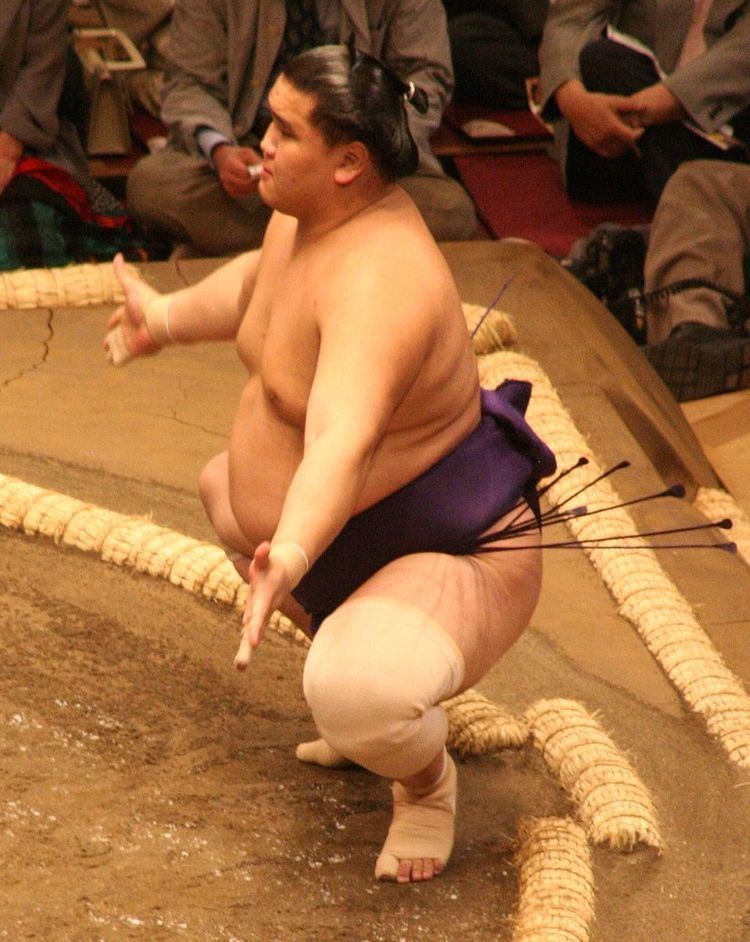Current rank see below Championships 2 (Juryo) Gold Stars 1 (Hakuho) Role Sumo Wrestler Height 1.88 m Martial art Sumo | Debut March, 2001 Special Prizes Fighting Spirit (1) Name Shotenro Taishi Makuuchi rank Maegashira (since 2012) Weight 153 kg | |
 | ||
Highest rank Maegashira 2 (July, 2009) Similar People Asasekiryu Taro, Tokitenku Yoshiaki, Kitataiki Akeyoshi, Tamawashi Ichiro, Wakanosato Shinobu | ||
Shōtenrō Taishi (born 31 January 1982 as Nyamsuren Dagdandorj) is a sumo wrestler from Khovd Province, Mongolia. He joined professional sumo in 2001 and was known as Musashiryū Taishi until 2007. He made the top makuuchi division for the first time in 2009 and his highest rank has been maegashira 2. He wrestles for Fujishima stable (formerly Musashigawa stable).
Contents
Early life and sumo background

It has been reported that in his childhood in Ulan Bator he lived in the same apartment complex as future sumo contemporary Mōkonami, though they never met in person. As an amateur, Dagdandorj took third place in the open weight division in the Junior World Sumo Championships in 2000. He began his professional career in March 2001, at the same time as Hakuhō. He was given the shikona of Musashiryū, the prefix being a common one at Musashigawa stable.
Career
His rise through the ranks was relatively smooth until he reached the third highest makushita division in January 2003, where an early injury put him out of action and dropped him back to the sandanme division. He continued to struggle with his own sumo and injuries in these two divisions for the next five years, changing his shikona to Shōtenrō in 2007 in a bid to improve his fortunes. When he finally found his stride again, his steady rise to the top division was a stark contrast to his previous struggles; he reached makuuchi after winning two consecutive jūryō division championships, only the third post-war wrestler after Kushimaumi and Miyabiyama to achieve this feat. All in all, it had taken him 48 tournaments from his professional debut to reach the top makuuchi division, the third slowest at the time amongst foreign born wrestlers. In July 2009 he was awarded the Fighting Spirit Prize for his record of eleven wins and four losses. In the September tournament he won his first kinboshi, becoming the first maegashira in a year to defeat Hakuhō, but could win only one other match. A 9-6 score in the following tournament in November seemed to steady him, but he suffered a surprising slump in January 2010 and a poor 3-12 record saw him demoted to jūryō. He returned to the top division for the July 2010 tournament, and after slipping back to jūryō in September won promotion again for November 2010.
In 2011 he was one of several wrestlers investigated by the Sumo Association after his name was mentioned in a text message about match-fixing. The text, dating from May 2010, was sent by low ranker Enatsukasa, an alleged go-between, to jūryō wrestler Chiyohakuho and said, "the match with Shotenro is for real", implying that bouts with other wrestlers were being fixed. Shōtenrō vehemently denied any involvement in bout-rigging, and in April 2011 was found not guilty by the investigative panel.
He missed the November 2011 tournament after undergoing surgery for appendicitis, dropping to the jūryō division in January. Despite only making a bare majority of eight wins at jūryō 5, this was enough for an immediate return to makuuchi. He had a superb start to the March tournament, winning nine of his first ten matches, but he faded in the home stretch, losing his last five bouts as he was matched against higher ranking opponents. He remained a middle ranking maegashira for several tournaments before finally being demoted to the second division for the March 2014 tournament. He was unable to return to makuuchi, and in September 2015 he lost his sekitori status and was demoted to the makushita division. A 4-3 record at the rank of Makushita #1 in January 2016 was enough to earn promotion back to jūryō for the March tournament in Osaka.
Fighting style
He is an oshi-sumo specialist, preferring pushing and thrusting techniques. He is however also capable of fighting on the mawashi or belt, where he prefers a migi-yotsu (left hand outside, right hand inside) grip. His most common winning move is oshi-dashi (push out), followed by yori-kiri (force out).
Personal life
Shōtenrō married the sister of fellow Mongolian sekitori Kyokutenhō in 2011, and the reception was held in June 2012. As brothers-in-law, the two wrestlers could no longer meet in competition.
